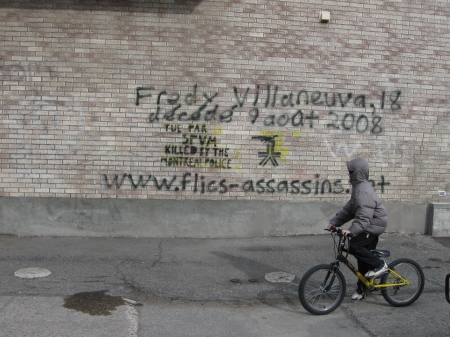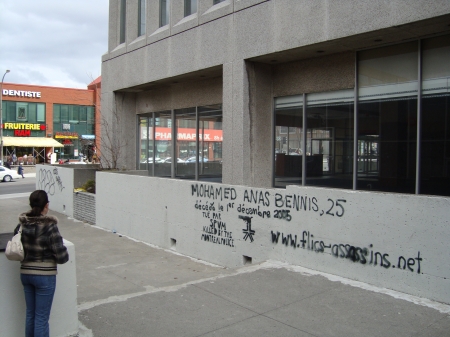
Location in Montréal-Nord where Freddy Villaneuva was killed in the summer of 2008
An anonymous group has been drawing attention to the conduct of the SPVM, the Montreal police force, by commemorating the places around the city where they alledge police actions have led to deaths of 43 individuals from 1987 to the present. While groups like the Collectif opposé à la brutalité policière (COBP) are a well-known presence, this group is unaffiliated and anonymous, leaving only a provocative message and a website address.

Location in Côte-des-Neiges where Mohammed Anis Bennis was killed in 2005
The message these individuals leave at each site follows the same pattern: the name of the deceased and their age spray-painted by hand, along with a stencil that reads “Tué par SPVM Killed by Montreal police” and includes their website, www.flics-assassins.net. On this website, they describe their cause in greater detail:
From the shooting death of Anthony Griffin, 19, outside a police station in NDG in 1987, to last year’s death of Fredy Villaneuva, 18, at Parc Henri-Bourassa in Montreal-Nord, 43 individuals have been killed by the Montreal police. Whether by bullets, pepper spray, electric shocks, beatings (or, in one case, running over a youth with a police car) the Service de la Police de Montréal (SPVM), have acted with impunity.
While many Montrealers may becoming weirdly accustomed to the death of a young men in altercations with police, having these tragic events reflected back in this location-specific manner is new. On the sides of innocuous buildings, we are reminded that real people were killed by the police – sometimes, it would appear, without due cause – in the spaces we inhabit in our day-to-day lives.
Will this new strategy reignite the outrage that followed many of these events and prompt the public to demand better scrutiny of our police force? And more importantly, will public outrage (hardly a precious commodity) be enough to address the root problems of these incidents, such as lack of access to jobs and higher education, high youth delinquency, and the systemic racism within the SPVM?

7 comments
How are lack of access to jobs and higher education a root cause of police killing youth with impunity? It sounds like blaming the victim.
“And more importantly, will public outrage … be enough to address the root problems of these incidents, such as lack of access to jobs and higher education, high youth delinquency, and the systemic racism within the SPVM?”
Talk about a loaded question! For example, is there really systematic racism within the SPVM? Has this been proven or just assumed because, you know, the cops are all those people…
And is outrage going to conjure up employment? In this case, let’s outrage ourselves out of this recession!
An aside: maybe we can outrage the Education Ministry while we’re at it so they can hire more professors and not raise tuition. But that would involve criticizing the Liberal government and the effects of their policy on Montréal (and acknowledging they exist in the first place).
Spacing Toronto is all over McGuinty’s latest outrages, whatever they may be this week — what’s the deal here, chums?
The incidents like that of Freddy Villaneuva being killed by police last summer are usually the tragic result of long-standing tension between disenfranchised youth and local police. How, exactly, that situation was created is still subject to debate, but these situations tend to arise in areas that are poorly serviced and (often) racially-profiled. This is NOT blaming the victim.
As far as whether or not this method is effective, that’s a tough one – one man’s memorial is a shop-owner’s pain-in-the-ass. I suppose these aren’t really tributes or memorials, and in the eyes of too may, these won’t even be read, just viewed as the collective mass of urban visual pollution.
I would hope that people think long and hard about these issues, and with that in mind, the bare bones approach is key. It’s stark reality, quick and to the point.
I would like to see something more provocative though. Montreal has a ridiculously low murder rate (and I don’t think police victims are counted) for a city of this size, but we also have two of the top ten most corrupt police forces in Canada operating here (the SQ, #3 and the SPVM #4). Is there a relation? I’ve seen SPVM casually talking with drug dealers; I’ve seen dealers dealing with cops. It seems as though the people of Montreal would rather have a thick gray line than a thin blue one, and maybe that’s whats keeping us from going the way of Baltimore or Detroit.
In the end I’m glad these guys are doing what they do – Montreal has some terrifying and extremely depressing police-brutality stories. But we also live in a relatively crime-free oasis – I’m at a loss either way because aside from pointing out where these people died, or having an anti-police brutality riot, I don’t know of what can possibly be done to ameliorate the situation.
newurbanshapes: so how many visible minorities have to be killed with impunity before we can consider the idea reasonable? It seems like the obvious explanation.
Jakob: being unemployed is not a crime.
Not having a degree is not a crime.
Racial profiling? A crime.
Racially motivated killing? A crime.
So let’s blame the criminals, not some sociological patterns. Someone pulled the trigger.
I’d love to see a follow-up article on racial profiling. If it’s the case, it’s almost certainly showing up throughout the SPVM’s operations.
Dans une optique urbaine, parce que c’est bien d’un blog urbain qu’il s’agit, je pense que ces grafs contribuent au sentiment d’insécurité davantage que les flics. Et juste pour ça, je trouve que c’est une mauvaise idée.
@ Haran
Racially motivated killing? A crime.
Ben, oui. Mais ça n’a pas été prouvé. Il y a des enquêtes pour ça, et dans le cas de Villanueva, ça n’a tout simplement pas été prouvé. Maintenant, tu peux critiquer les “enquêtes spéciales” menées par d’autres corps de police. Oui. Mais de lancer des accusations non fondées sur un blogue, ça n’avance à rien.
for examples of racism withing the montreal police, check our CRARR, who have lots of solid information.
http://www.crarr.org/?q=node/77
http://www.crarr.org/?q=node/59
http://www.cbc.ca/news/background/racial_profiling/
i like public interventions like this, that keep our attention to important issues in creative ways.